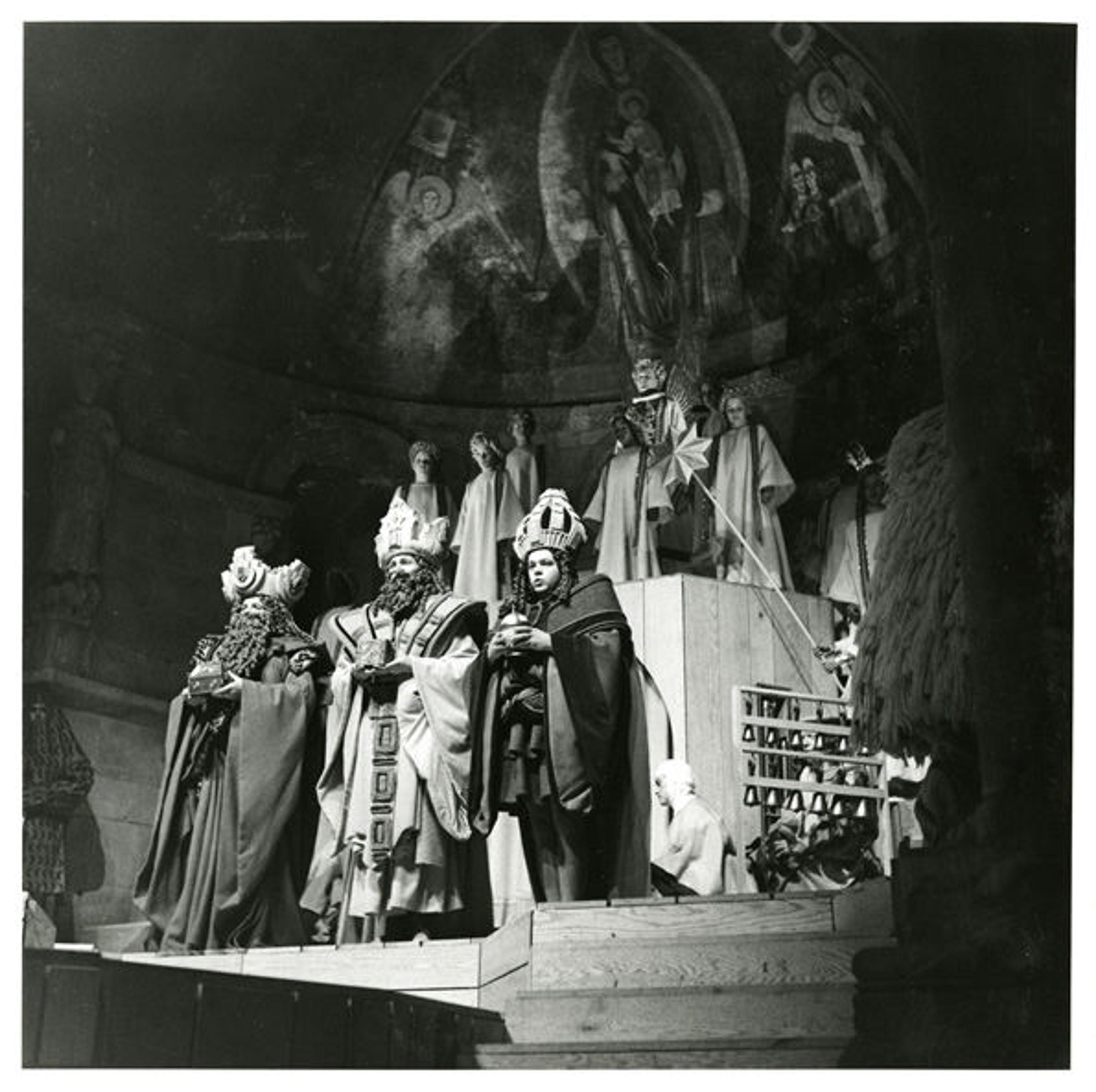
The Play of Herod. New York Pro Musica performances at The Cloisters, 1963
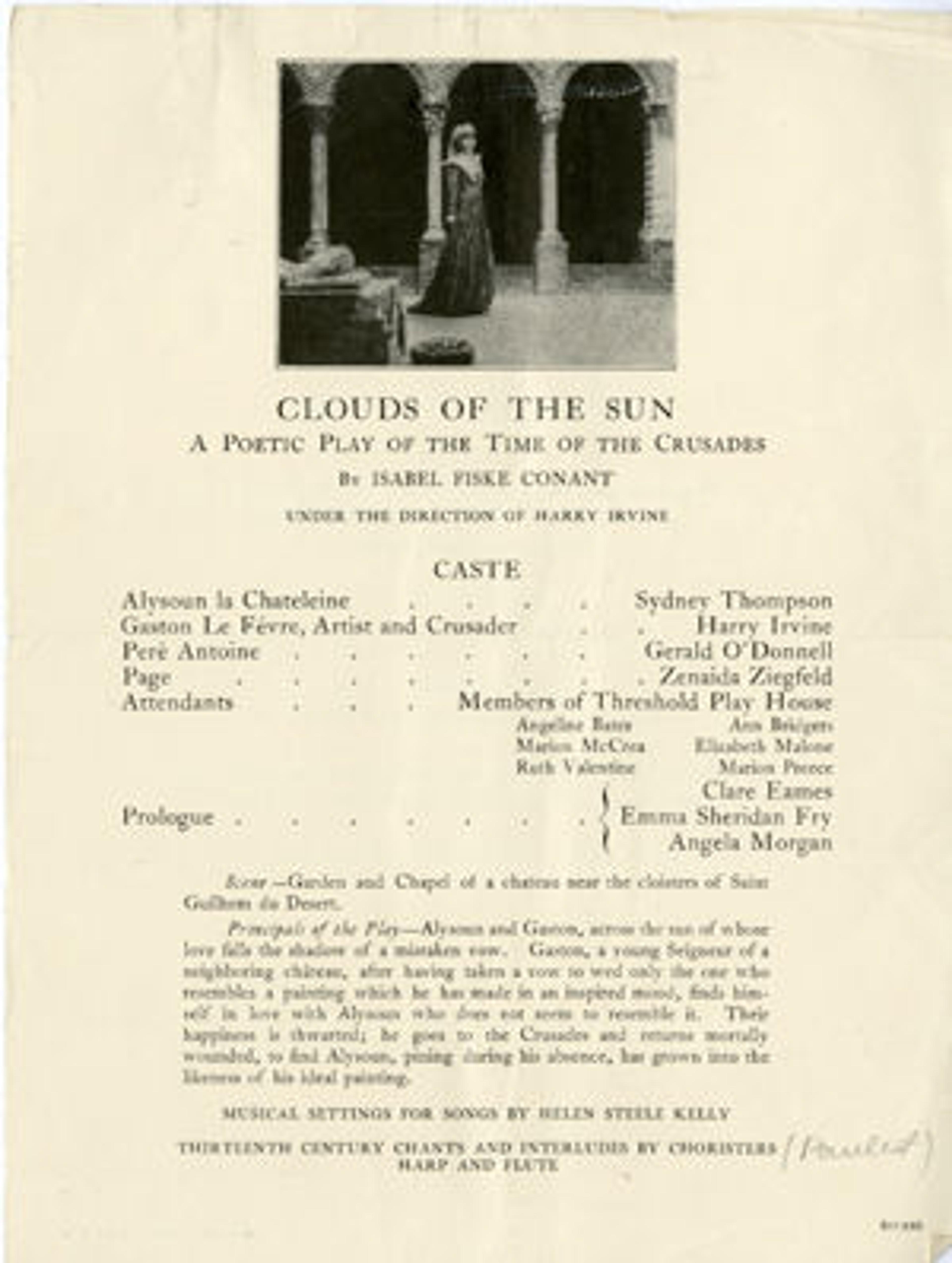
«Although theatrical plays had been presented at the original Cloisters museum at 699 Fort Washington Avenue until its closing in February 1936, it was not until the performance of The Miracle of Theophilus at The Cloisters' current home in January 1942 that a medieval drama was produced for the first time. Envisioned and organized by the curatorial staff, with a text translated from the original French into English by Curator James Rorimer—later director of The Metropolitan Museum of Art—and costumes designed by Associate Curator Margaret Freeman, the thirteenth-century play was enjoyed by a group of Museum members on the Feast of the Epiphany. Thus began a tradition of medieval theatrical performances at The Cloisters.»
Program from Clouds of the Sun, performed at the original Cloisters, 1922
With its evocative architectural setting and renowned medieval art collection, The Cloisters has long been considered an ideal venue for medieval theater. The timing of The Miracle of Theophilus, however, was almost providential: the Japanese had just attacked Pearl Harbor a month earlier, and Rorimer considered Theophilus "one of the delightful interludes in a mad world," an event that was "the climax to our prewar life." (Rorimer became well known after the war as one of the "Monuments Men" recovering art looted by the Nazis, and will be portrayed by Matt Damon in an upcoming film, The Monuments Men, to be released in December.)
The power of theater to transport viewers to an imaginary world was emphasized in many letters between the audience and staff following the performance. One of the attendees, Irene Lewisohn (founder of the Neighborhood Playhouse, which supplied all of the performance's actors), attached a letter from a very young Eli Wallach reiterating the importance of theater arts in an uncertain world, an importance underscored by the Museum's special exhibition, The Drama and The Other Arts (1943), which exhibition materials promoted as "an occasional escape . . . [and] . . . relief from war tension." Initially presented in the Main Building on Fifth Avenue, part of this exhibition was later moved to The Cloisters, renamed Medieval Theatre Arts to reflect its focus on the Middle Ages, where it was on display April through July, 1943.

The Miracle of Theophilus, 1942
On December 19, 1954, the Second Shepherd's Play, as adapted by John Gassner, was televised on CBS's Omnibus series. (A performance of The Vienna Choir Boys at The Cloisters was filmed for the same broadcast.) Hosted by Alastair Cooke, the twelve-minute play was filmed across the Cuxa Cloister, the Romanesque Hall, and the Pontaut Chapter House, and included a live sheep as part of its cast. Logistical complexities necessitated the closing of the Museum all day on December 19—a decision so unusual it had to be approved by the Museum's Board of Trustees. The actors and the choristers had only two days of on-site rehearsals during early-evening hours to prepare for the live broadcast. Calling the film project "one of the most complex undertakings television has ever experienced," Robert Saudek of the Ford Foundation (which funded the project) later compared its challenges to televising the coronation of Queen Elizabeth II the previous year.
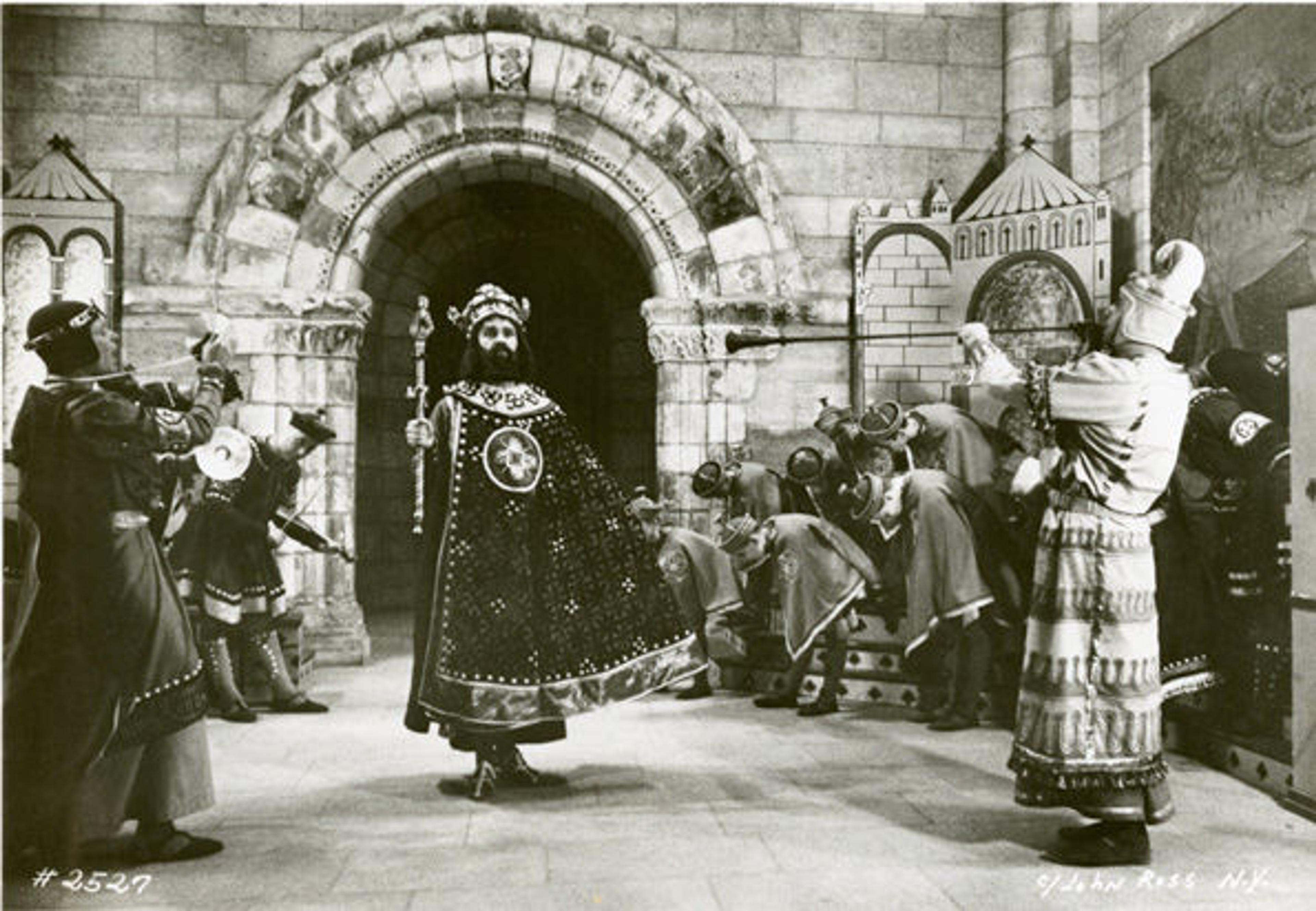
The Play of Daniel. New York Pro Musica. Performance in the Romanesque Hall of The Cloisters, 1958
One of the most recognized theatrical presentation in the annals of The Cloisters is New York Pro Musica's modern presentation of The Play of Daniel, directed by the legendary Noah Greenberg in January 1958. The performance of this liturgical play from twelfth-century Beauvais, France, effectively transformed the early-music scene in New York. The team assembled for these performances was unrivaled in its time, and boasted longtime New York City Ballet General Director Lincoln Kirstein as producer, Williamstown Theatre Festival Executive Artistic Director Nikos Psacharopoulos as stage director, and an English narration written by W. H. Auden. The cast included countertenor Russell Oberlin, and instrumentalist Paul Maynard, who would later carry Greenberg's torch after the director's untimely death in 1966. The fully staged and costumed production was enhanced by the generosity of other institutions that lent instruments (including a 1405 straight trumpet from Siena lent by Williams College, as well as a set of English bells from The Brearley School) and props (a seven-branch candelabrum on loan from The Jewish Museum).
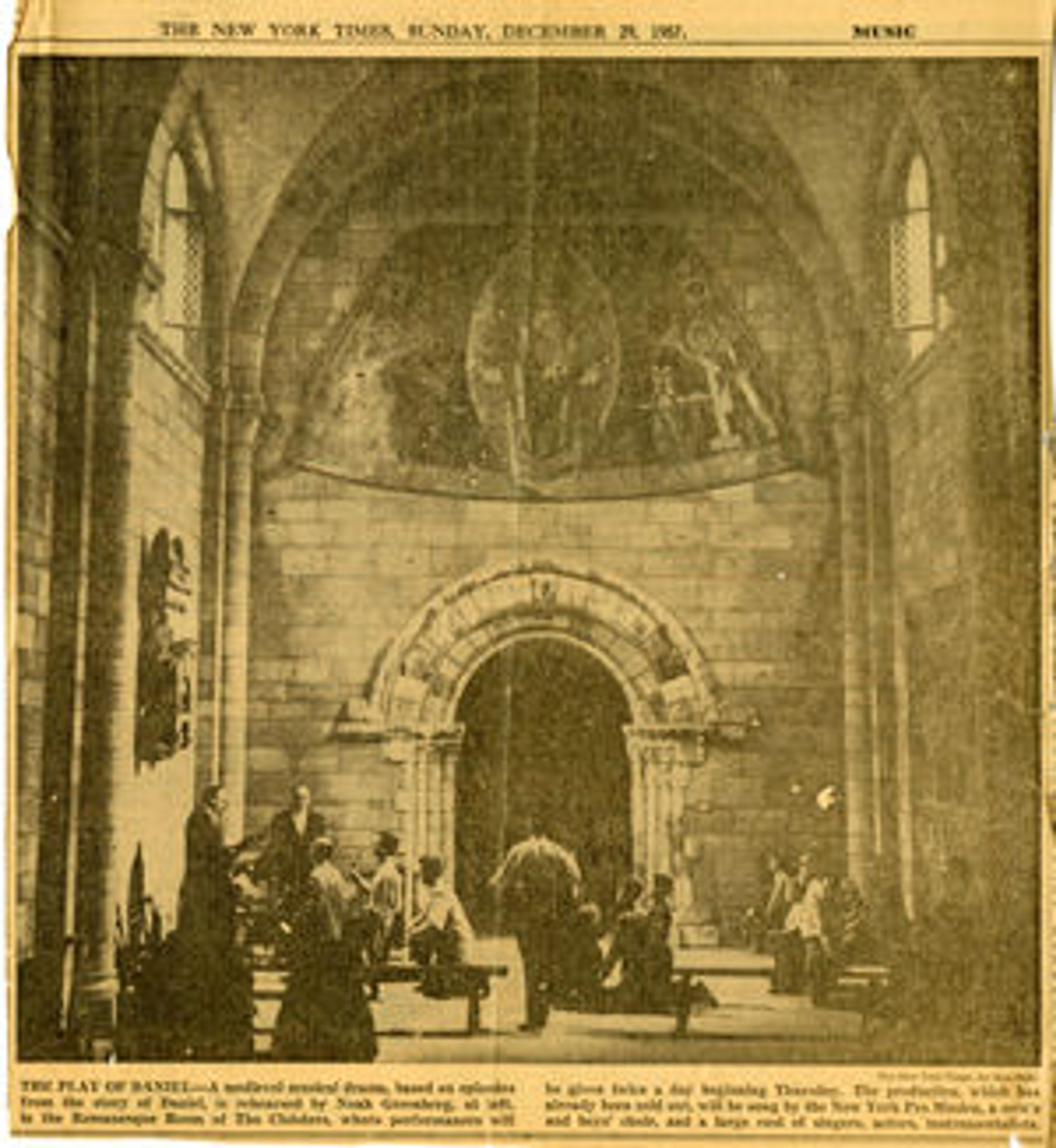
Left: The Play of Daniel. New York Pro Musica. Photograph of a rehearsal published in the New York Times, December 29, 1957
The performances received general acclaim from audiences who, according to a December 1961 article in the Gaslight Review Program Guide, braved " winter weather, stormed the marvelous museum high above the Hudson . . . to see New York's newest 'hit'—written in 1150." The Archbishop of Spoleto reportedly exclaimed: "The Americans have shown us a genuinely religious drama." It was filmed at The Cloisters in June 1965, to be televised on more than ninety National Educational Television (now PBS) stations as a Christmas special that year and many years to follow. Productions and performances inspired by Greenberg's historical undertaking flourished in the subsequent decades, both in the United States and abroad. For a summary of these modern performances, see Fletcher Collins, Jr.'s essay, "The Play of Daniel in Modern Performance," from The Play of Daniel: Critical Essays (Medieval Institute Publications, 1997).
New York Pro Musica did not return to The Cloisters with The Play of Daniel for many years—due, in part, to the construction of the Fuentidueña Chapel from 1958–61. Instead, over one week in December 1963, the group presented The Play of Herod, comprising two plays (The Representation of Herod and The Slaying of the Children) excerpted from the so-called Fleury Playbook from around 1200. While the 1958 Play of Daniel was staged in the Romanesque Hall, 1963's Play of Herod was staged in the new Fuentidueña Chapel, featuring a twelfth-century apse from the small commune in Segovia.

Left: The Play of Daniel. New York Pro Musica. Program for performances at The Cloisters, 1958
Like The Play of Daniel—and, for that matter, all other theatrical performances at The Cloisters—it was the combination of music, drama, and an evocative setting that compelled and mesmerized the audience. The art critic Nelson Lansdale described The Cloisters at night as "just short of miraculous . . . [where] the French and German virgins [stood] in what seemed to be pools of their own light." (At least four of the performances started at 9:00 p.m.) Ross Parmenter of the New York Times concurred: "Seldom does one see a production in which setting, sound, and sight form so unified a whole. Again and again it was as if figures from other parts of the museum had stepped from their frames or their pedestals to take part in the performances and the play as a whole was like a painting come to life with flesh and blood performers." Given the enormously positive response, audio recordings of these two productions were made immediately—The Play of Daniel in 1958, and The Play of Herod in 1964, both released by Decca. The Pro Musica production of The Play of Daniel returned to The Cloisters only one more time, in January 1972, where audiences enjoyed a medieval-style supper of rich soup, barley bread, and mulled wine before the performances.
Since the 1970s other early-music ensembles—almost all of whom were inspired by New York Pro Musica—began to perform staged works at The Cloisters. In 1972, The Waverly Consort under Director Michael Jaffee, performed Las Cantigas de Santa Maria: Medieval Music and Verse in the Court of Alfonso X, "el Sabio." Although a series of songs rather than a dramatic work, the performance was nevertheless fully staged, costumed, and, like the Pro Musica's two productions, quickly recorded (Vanguard).

The Play of Daniel. New York Pro Musica. Performance by the Doorway from Moutiers-Saint-Jean (32.147), The Cloisters, 1965
Starting in the early 1990s, the Ensemble for Early Music, directed by Frederick Renz (who had appeared with New York Pro Musica's The Play of Daniel at The Cloisters in 1972), presented a series of medieval dramas: The Play of Daniel (1990, 1996), The Resurrection Play of Tours (1993), Herod and the Innocents (1991), The Resurrection of Lazarus and The Conversion of Saint Paul (1994, 1995), and The Play of Mary Magdalene (1997). Except for the first two plays, which came from different manuscript sources, the Ensemble for Early Music methodically produced and performed all of the plays collected in the so-called Fleury Playbook at The Cloisters in just a few years' time.
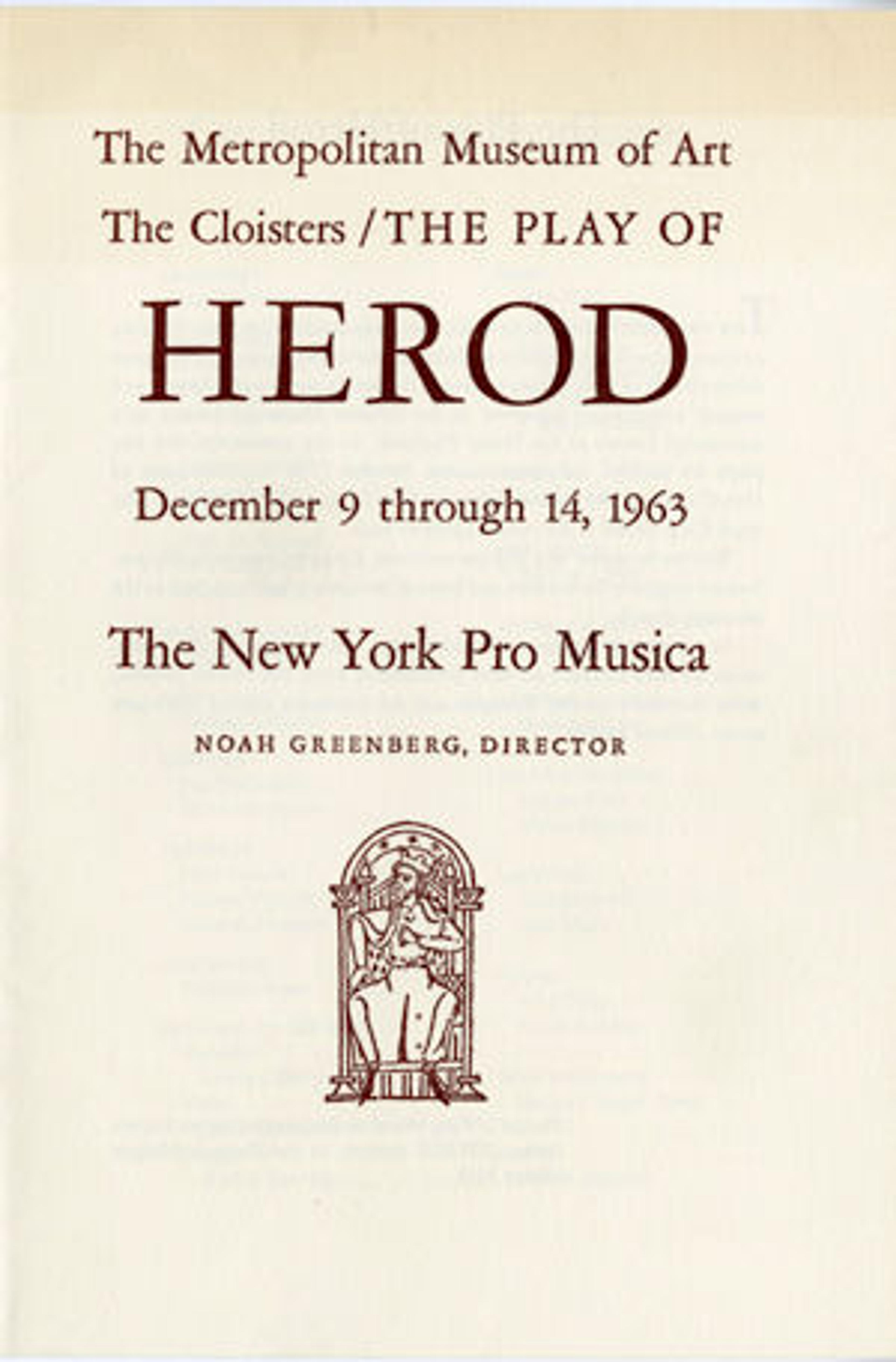
From 1992 to 1995 the Bon Accord Theatre Company, under the directorship of B. D. Bills, performed a number of late medieval plays at The Cloisters, including French farces La Farce de Maître Pierre Pathelin and Le Cuvier (The Washtub), as well as the morality plays The Everyman and Mankind. During the same period the Education Office of The Cloisters also presented a few works of modest scale: in 1993 The Play of Saint Nicholas was performed as a free event on December 6—the saint's feast day; three years later, The Three Kings was presented on the Feast of the Epiphany as part of a weekend gallery program for families. The Education Office continued their collaborative relationship with the Ensemble for Early Music, presenting the thirteenth-century El Poema de Fernán González, written by a monk at the Benedictine monastery of San Pedro at Arlanza—the original home of two monumental frescos at The Cloisters that served as the backdrop for the performance.
Above: Drew Minter (Stage Director, The Play of Daniel, 2008 and 2013). Watercolor based on Enthroned Virgin and Child. Burgundy, vicinity of Autun (47.101.15)
Initiated by the Museum's early-music series, Concerts at The Cloisters, The Play of Daniel was revived in 2008 to commemorate the fiftieth anniversary of Noah Greenberg's modern premiere of this pivotal work. (Two scenes from this production, "Balthasar's Feast" and "Daniel Interpreting the Writing on the Wall," are currenly available on MetMedia.) With Drew Minter as stage director, Stephen Dobay as set designer, and Brian Barnett as lighting designer, the new production was conceived exclusively for the Fuentidueña Chapel. Costume designer Sasha Richter took as her inspiration the works of art in the collection, most notably the costumes of the two magi that were copied from those of the three magi on the twelfth-century fresco above the stage. (Drew Minter, best known as a countertenor and operatic stage director, but also an accomplished watercolorist, sketched a group of sculptures in the collection while contemplating the staging.)
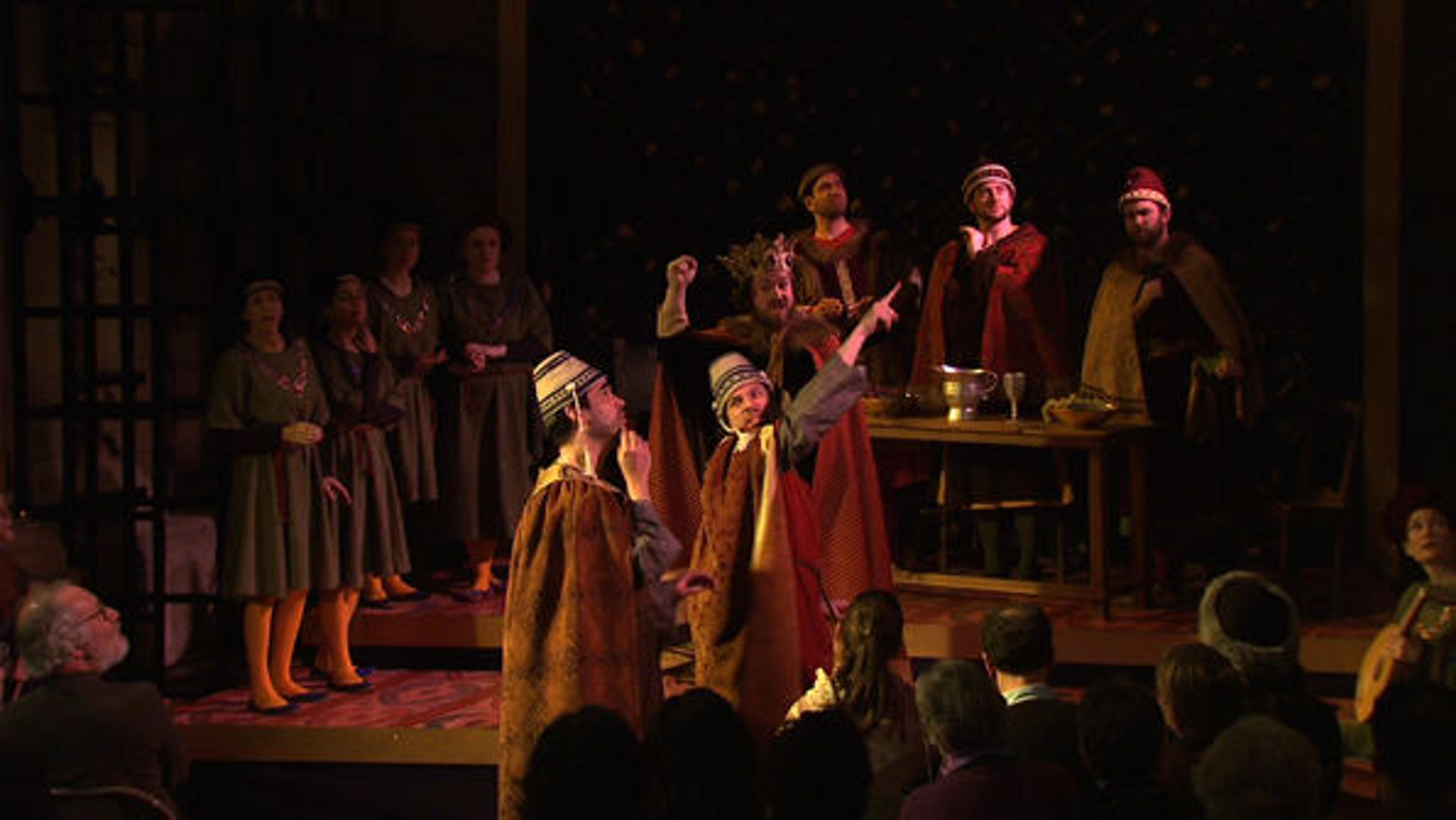
Two magi attempting to decipher the handwriting on the wall, The Play of Daniel, 2008
The influence of Greenberg's 1958 performances was more than palpable. Many members of the cast had performed in different productions of The Play of Daniel (Lucy Cross played the psaltery in the Pro Musica performances at The Cloisters, thus serving as a direct link between the 1972 and 2008 productions). Dozens of audience members came with The Play of Daniel LP in their hands; some declared to have waited fifty years to see it at The Cloisters again. When countertenor Russell Oberlin—from the 1958 cast—attended one of the performances, he received a standing ovation not only from the audience, but the entire cast and crew. This production, with Mary Anne Ballard as its music director, was presented again in January 2013, as part of The Cloisters' seventy-fifth anniversary celebrations.

Left to right: The Play of Daniel, New York Pro Musica. Decca album cover; The Play of Herod, New York Pro Musica. Decca album cover photographed at The Cloisters; Las Cantigas de Santa Maria, The Waverly Consort. Vanguard album cover photographed at The Cloisters
Behind the success of these performances lay tremendous technical and logistical challenges: The Cloisters was not built as a theater, thus it lacks any of the technical facilities required of even modest theatrical productions; and the fact that performances are held in galleries filled with fragile works of art makes on-site rehearsal, stage construction, lighting set-up, or even seating, difficult. These have been daunting tasks in the past, and will continue to pose challenges in the foreseeable future, as the landmark status of The Cloisters renders major modifications nearly impossible. A 1954 memo strategizing the CBS filming of The Vienna Choir Boys and the Second Shepherd's Play states that all the technical equipment was scheduled to vacate The Cloisters by 1:00 a.m. following the broadcast, and that "burial services for any of us who did not survive this will take place Monday morning."
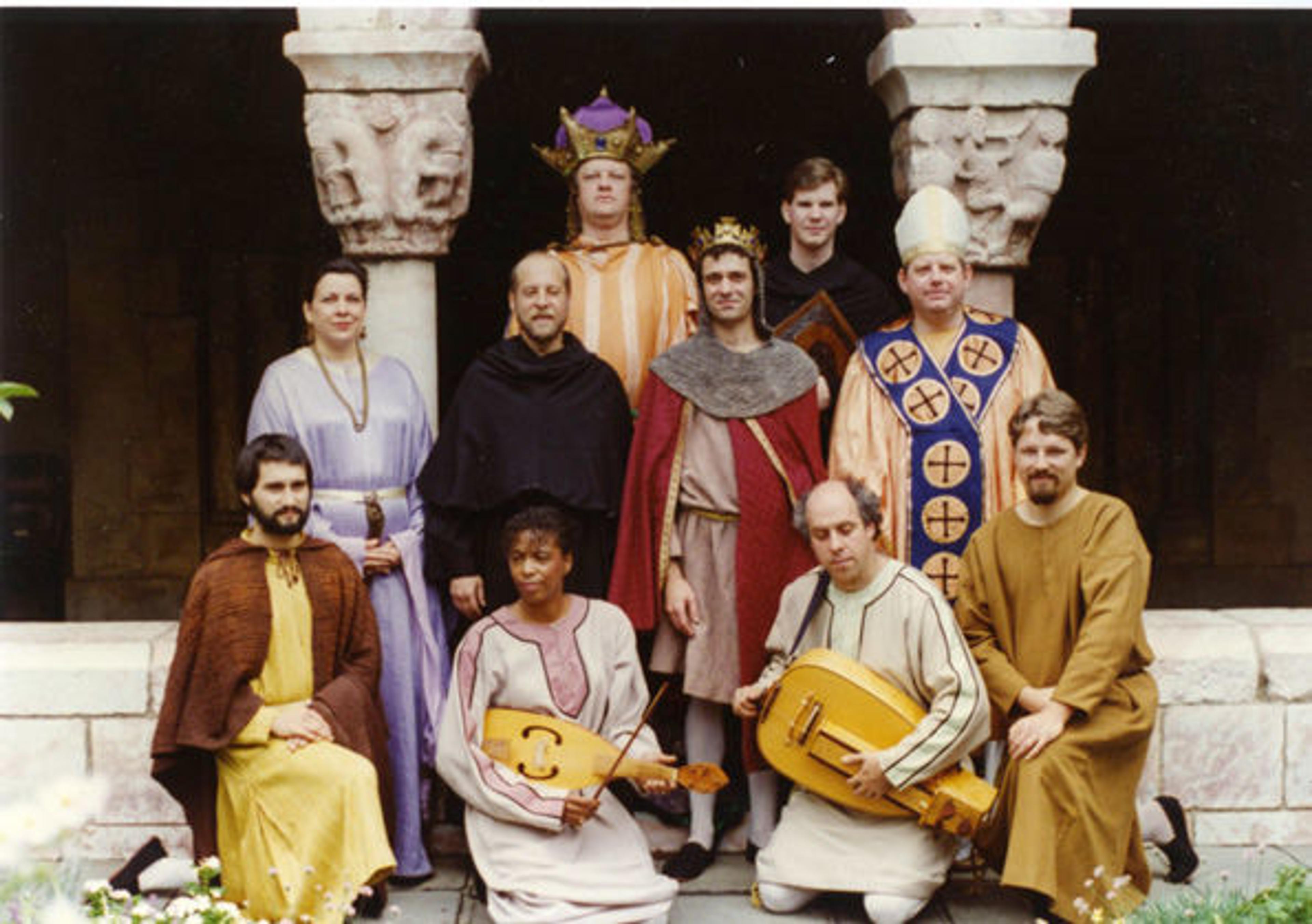
Cast of El Poema de Fernán González, September 1994
Considering the proposal of the National Educational Television filming of The Play of Daniel in 1965, Curator Thomas Hoving acknowledged that the project "will be very difficult work and annoying at times," but reasoned that by making the galleries available for the filming, The Cloisters "would fulfill our tacit obligation to educational television." This "tacit obligation" is, of course, not limited to "educational television" but education in its broadest sense: medieval drama helps put into context both the objects in the collection and, conversely, the dramas themselves. Indeed, what more appropriate venue to stage a liturgical play than a twelfth-century apse from Spain? The Moutiers-Saint-Jean doorway from thirteenth-century Burgundy, which served as backdrop for The Miracle of Theophilus in 1942, may very well serve another production in the future. Images of Saint Nicholas, the Virgin Mary, the Three Kings, and Daniel abound, creating a constant dialogue between art and drama. The Cloisters, with its unique assemblage of medieval art and architecture, continues to evoke and inspire; so will the Museum continue to complement its collection with music and drama of the Middle Ages—a tradition to which The Cloisters has steadfastly committed itself over the past seventy-five years.
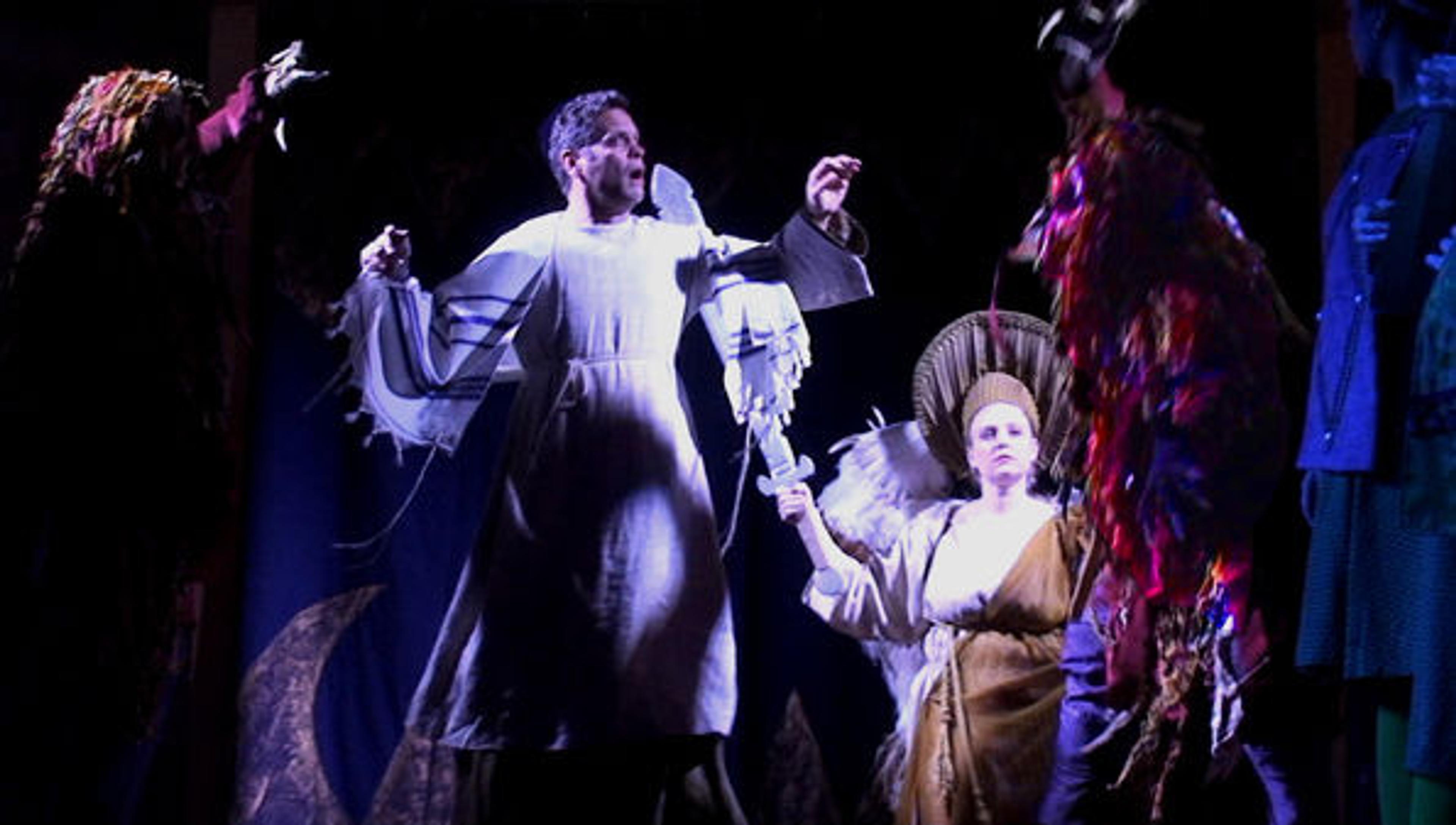
Daniel (James Ruff) rescued by the Angel (Elizabeth Baber), The Play of Daniel, 2013